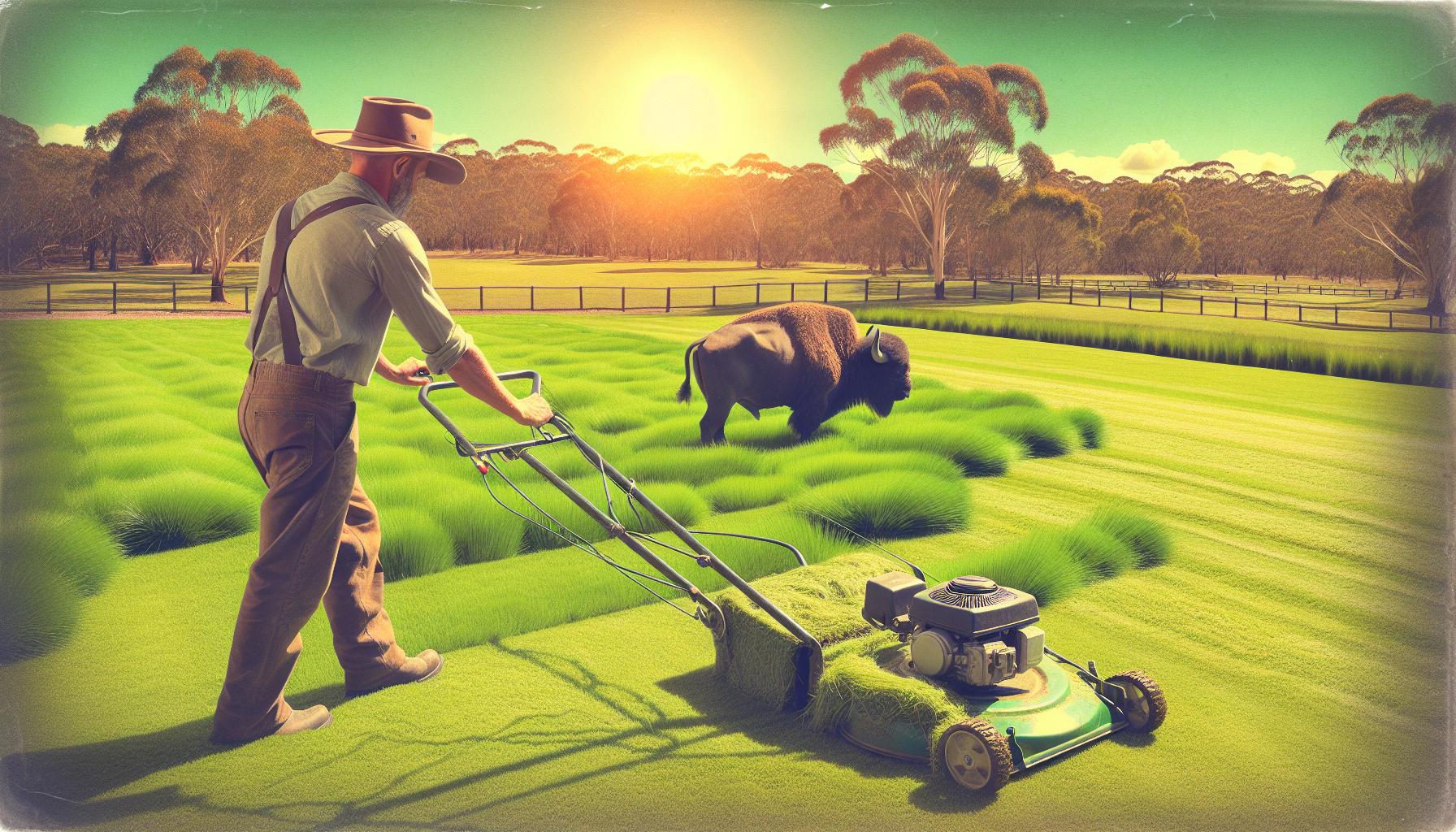
When to Mow New Buffalo Turf for a Lush Lawn: Best Tips and Timing
Establishing new buffalo turf can transform any garden into a lush green oasis, but timing is crucial for successful growth. Knowing when to mow new buffalo turf not only promotes healthy development but also enhances its resilience against pests and diseases. This article will guide readers through the best practices for mowing new turf, ensuring they achieve a thriving lawn that stands the test of time.
Understanding the right time to mow is essential for achieving optimal results. By following the guidance in this article, homeowners can ensure their buffalo turf develops properly, staying lush and green.
Understanding Buffalo Turf
Buffalo turf, known for its durability and adaptability, suits various climates and soil types. Understanding its characteristics and benefits is essential for effective lawn care.
Characteristics of Buffalo Turf
- Drought Resistance: Buffalo turf withstands dry conditions well. It requires less water compared to other grass types, making it suitable for areas with limited rainfall.
- Shade Tolerance: Buffalo grass performs effectively in partially shaded regions, unlike many other grasses that struggle without full sun.
- Thick Growth Habit: It develops a dense, lush lawn that provides a robust barrier against weeds. This thick growth also enhances visual appeal.
- Low Maintenance: Buffalo turf requires minimal fertilisation and mowing, making lawn care less time-consuming and more straightforward.
- Warm-Season Grass: It thrives in warmer temperatures, growing optimally during the spring and summer months while remaining dormant in cooler winters.
Benefits of Using Buffalo Turf
- Environmental Resilience: Buffalo turf adapts well to varied environmental conditions, ensuring a resilient lawn with reduced susceptibility to diseases and pests.
- Cost-Effective: Its low water and fertilisation needs lower overall maintenance costs. The long-term durability translates to fewer replacement needs.
- Great for Families: The dense texture of buffalo turf provides a safe space for children and pets. The grass withstands wear and tear from foot traffic effectively.
- Aesthetic Appeal: The rich green colour and thick blades create an attractive lawn. It enhances outdoor spaces, adding value to property.
- Soil Health Improvement: As buffalo turf grows, it contributes to soil health by preventing erosion. Its deep root systems enhance soil structure and moisture retention.
Best Time to Mow New Buffalo Turf

Timing plays a crucial role in mowing new buffalo turf. Proper mowing helps promote healthy growth and resilience against pests and diseases.
Seasonal Considerations
Mowing occurs best when buffalo turf reaches a height of 7.5 to 10 cm, typically in spring or early summer. This timing allows the grass to establish strong roots. Mowing during the active growing season—from late spring through early autumn—supports optimal turf health. Avoid mowing during extreme heat or cold, as this can stress the grass and impact growth.
Weather Conditions
Weather conditions significantly affect mowing decisions. Mow when the turf is dry to prevent clumping and ensure an even cut. Rainy or damp conditions lead to uneven mowing and can damage the grass. Ideal temperatures for mowing range between 15°C and 25°C. Mowing under these conditions helps maintain a healthy lawn without causing additional stress to the grass.
Signs Your Buffalo Turf is Ready for Mowing
Identifying the right time to mow new buffalo turf ensures healthy and robust growth. Look for these indicators:
Grass Growth Indicators
Grass should reach a height of 7.5 to 10 cm before mowing. At this height, buffalo turf demonstrates strong growth and resilience. A vivid green colour signifies good health, while even growth across the areas indicates turf readiness. Checking for firmness underfoot also suggests established roots, making it a suitable time for the first cut.
Tiller Development
Tiller development plays a crucial role in determining mowing readiness. Buffalo turf should show numerous tillers—side shoots emerging from the base of existing grass blades—indicating a dense and healthy lawn. A well-developed network of tillers not only enhances density but also supports the grass during mowing by distributing stress evenly. Observing a good amount of tiller growth signals that the turf can withstand the initial mowing, promoting further development.
Mowing Techniques for New Buffalo Turf
Mowing new buffalo turf requires attention to height and frequency for optimal growth and health.
Recommended Mowing Height
The ideal mowing height for new buffalo turf is between 5 cm and 7.5 cm. Mowing at this height encourages strong root development and promotes a dense canopy, which reduces weed establishment. Cutting too low stresses the grass and can inhibit growth. When assessing the mowing height, he or she should ensure that the grass appears vibrant and robust, as this indicates healthy turf ready for maintenance.
Mowing Frequency
Mowing frequency depends on the growth rate of the grass, typically occurring every 1 to 2 weeks during the active growing season. Frequent mowing encourages lateral growth and enhances turf density. It is essential to avoid removing more than one-third of the grass blade height in a single mowing session, as this practice prevents unnecessary stress. Monitoring grass growth and adjusting the mowing schedule according to seasonal conditions ensures a lush and resilient lawn.
Common Mistakes to Avoid
Avoiding common pitfalls ensures healthy growth and longevity for new buffalo turf. Below are key mistakes to steer clear of.
Over-Mowing New Turf
Over-mowing can significantly hinder the establishment of new buffalo turf. Mowing too frequently or too short stresses the grass and disrupts root development. Maintaining a height of 5 cm to 7.5 cm is essential for promoting strong roots while minimising weed competition. Stick to a schedule of mowing every 1 to 2 weeks during the active growing season. Adjusting the mowing frequency according to the turf’s growth can prevent unnecessary stress.
Ignoring Environmental Factors
Ignoring environmental factors can adversely affect new buffalo turf. Factors such as temperature, humidity, and soil moisture play crucial roles in turf health. Mowing during extreme heat or while the grass is wet can lead to uneven cuts and increased disease susceptibility. Optimal mowing occurs when temperatures range from 15°C to 25°C and the grass is dry. Monitoring weather conditions and turf health ensures better cutting outcomes and aids in establishing a resilient lawn.
Conclusion
Mowing new buffalo turf at the right time and with the correct techniques is crucial for establishing a healthy lawn. By waiting until the grass reaches the recommended height and ensuring optimal conditions for mowing, individuals can foster strong root development and resilience.
Monitoring the turf’s growth and adjusting mowing practices accordingly will lead to a lush and vibrant lawn. Avoiding common mistakes like over-mowing and cutting too short will further enhance the grass’s ability to thrive. With these guidelines in mind, anyone can enjoy the numerous benefits that buffalo turf has to offer, creating an attractive and sustainable outdoor space.
Frequently Asked Questions
What is buffalo turf and why is it preferred?
Buffalo turf is a warm-season grass known for its durability and adaptability. It offers benefits like drought resistance, low maintenance, and shade tolerance. Its thick growth habit makes it suitable for families and enhances soil health, making it a popular choice for lawns.
When is the best time to mow new buffalo turf?
The optimal time to mow new buffalo turf is when it reaches a height of 7.5 to 10 cm, typically in spring or early summer. This timing supports strong root establishment and promotes healthier growth during the active growing season.
How often should I mow my new buffalo turf?
It’s recommended to mow new buffalo turf every 1 to 2 weeks during the active growing season. This schedule helps maintain a healthy lawn without stressing the grass. Avoid cutting more than one-third of the blade height in one session.
What height should I mow buffalo turf?
The ideal mowing height for buffalo turf is between 5 cm and 7.5 cm. This height encourages strong root development and helps create a dense canopy, reducing weed establishment and promoting overall lawn health.
What signs indicate buffalo turf is ready to be mowed?
Indicators that buffalo turf is ready for mowing include reaching the recommended height, displaying a vivid green colour, even growth, firm underfoot, and multiple tillers. These signs suggest the grass has well-established roots and is ready for maintenance.
What mistakes should I avoid when mowing new buffalo turf?
Common mistakes include over-mowing, cutting too short, and ignoring environmental conditions. These practices can hinder turf establishment and lead to increased stress and disease susceptibility. Always keep an eye on growth and adjust mowing frequency accordingly.
Why is timing important when mowing new buffalo turf?
Timing is crucial because mowing at the wrong time can stress the grass and impede root development. Mowing when the turf is at the right height and dry promotes healthy growth and resilience against diseases and pests.
Can I mow buffalo turf during extreme weather?
It’s best to avoid mowing buffalo turf during extreme weather conditions, such as excessive heat or when the grass is wet. These factors can cause stress to the grass and lead to uneven cuts, which may increase the risk of disease.
